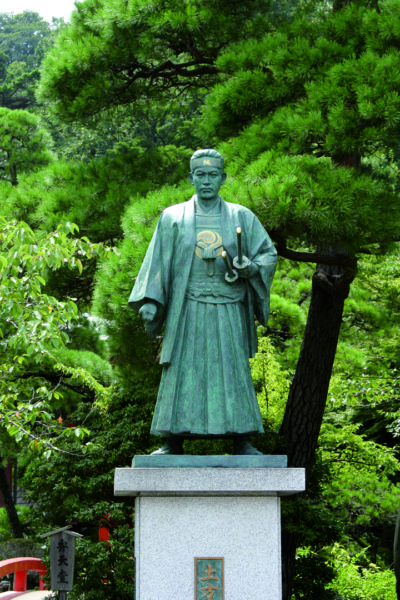| 1834 |
|
Birth of Kondō Isami, the third son of Miyagawa Hisajirō in Kamiishihara Village (the current Chōfu City).
His birth name is Katsugorō.
|
| 1835 |
|
Birth of Hijikata Toshizō, the fourth son of Hijikata Hayato Yoshiatsu in Ishida Village (the current Hino City). |
| 1844 |
|
Birth of Okita Sōji (believed to be in 1842). |
| 1858 |
|
Unification of Satō’s Tennen Rishin-ryū dojo, donator of Chinju Gozu Tennou Shrine (the old name of Yasaka-jinja Shrine). |
| 1859 |
|
Hijikata Toshizō joins the Tennen Rishin-ryū school. |
| 1861 |
|
Kondō Isami becomes the fourth head of Tennen Rishin-ryū. |
| 1863 |
2/8 |
The group of ronins leave Edo (old name of Tokyo), to go to Kyoto through the mountains. |
| 2/23 |
They arrive in Kyoto. |
| 3/12 |
Kondō and Hijikata stay in Kyoto under the supervision of the Shugoshoku. |
| 8/18 |
They dispatch the old imperial palace’s defense, officially take control of Kyoto and become known as the Shinsengumi. |
| 1864 |
6/5 |
They capture Furutaka Shuntarō, who confess. This is known as the Ikedaya Incident. |
| 7/19 |
Battle of Hamaguri Gomon. |
| 7/20 |
Battle of Yamazaki Tennouzan. |
| 8/2 |
The first order of Choshu. |
| 9/ |
Kondō heads to Edo to look for recruits. |
| 1865 |
4/ |
Their base is moved to Nishi Hongan-ji Temple. |
| 11/4 |
Kondō goes to Hiroshima. |
| 1866 |
9/12 |
Sanjō Kōsatsu Incident. |
| 1867 |
3/ |
Itō Kashitarō leaves the Shinsengumi. |
| 9/ |
Hijikata Toshizō leaves for Edo to look for recruits. |
| 10/14 |
Restoration of Imperial rule. |
| 11/18 |
Aburanokōji Incident. |
| 12/7 |
Tenma-ya Incident |
| 12/9 |
Declaration of the restoration of Imperial rule. |
| 12/16 |
They take defence at the Fushimi magistrate’s office. |
| 12/18 |
Kondō Isami encounters difficulties at Sumizome. |
| 1868 |
1/3 |
A battle starts at Toba-Fushimi. |
| 1/4 |
Inoue Genzaburō dies in battle. |
| 1/12 |
The warship Fujisan Maru departs from Osaka to Edo. |
| 1/15 |
The warship arrives in Shinagawa. |
| 3/1 |
As the Kōyō Chinbutai, the Shinsengumi leaves Edo for Kōfu. |
| 3/3 |
They rest at Satō’s house in Hino, and form the “Kasuga Forces” with the farmers. |
| 3/6 |
Battle of Katsunuma. |
| 4/3 |
Stationned in Nagareyama, Kondō, appears at the government army’s camp. |
| 4/23 |
Hijikata is wounded in the Battle of Utsunomiya. |
| 4/25 |
Kondō Isami is executed in Itabashi. |
| 5/30 |
Okita Sōji dies of illness in Sendagaya. |
| 8/21 |
Battle of Bonari Pass in Aizu. |
| 8/ |
Hijikata heads to Sendai. |
| 10/12 |
He leaves Sendai by boat. |
| 10/20 |
He lands in Washinoki, Hokkaido. |
| 10/26 |
He enters the Goryōkaku fortress. |
| 1869 |
4/9 |
The government army lands. |
| 4/12 |
Battle of Futamata. |
| 4/29 |
Return to Goryōkaku. |
| 5/6 |
Naval Battle of Miyakowan. Hijikata Toshizō and Yōshū Chikanobu boards the Kaiten warship. |
| 5/11 |
On his way out of Ippongi, Hijikata receives a bullet and dies in battle. |
| 5/18 |
Capitulation of the Goryōkaku fortress. |

